BB2C Focus Projects: Real World Problem Scenarios
Ten teachers from area schools signed up for professional development that had them partner with a local business representative, and in most cases it was someone they have never met (although there was that one time that we partnered a teacher with her fiance on accident). This is the way Problem Scenario Project starts out every summer.
The partnered set develops a problem scenario together during the summer session that will be given to the teacher's students to solve. During the fall semester the teacher and their business partner work with the students to stage the scenario and then act as a resource while they are developing solutions. In December, we bring them all back to reflect on what happened and find out what they learned.
For example: What would happen if Wolf Creek and Fort Frye schools were forced to consolidate? This is the problem that students in a government class at Fort Frye worked to solve with the help of their guidance counselor, Mary Beth Schultz; Bret Allphin, from Buckeye Hills Regional Council (bringing his vast knowledge of GIS and all things township related); and guest visits from Dr. Starcher, superintendent of Fort Frye Local, and Susie Coleman, principal of Waterford high school. Imagine the discussion about this scenario...
Here is a brief look at some of the reflections after going through the entire Problem Scenario Project process.
- Surprised - At the students' desire to have face-to-face interactions as part of their solutions.
- Inspired - Great opportunity to show kids there are more career options out there than what they already know; Inspiring kids now betters our odds 15 to 20 years down the road to have great employees who want to stay in the area.
- Excited - School administrators were excited about seeing the technology and learning about the project, seeing the final solutions, etc; Really cool to see others at the school beyond the specific teacher being interested in this project and this type of learning.
- Ready for more - It would be nice to have a fall partner (September – December) and then have a different business partner for spring (Jan-March).
- Different - Really liked the feedback that the students received from the business partner – totally different from the typical classroom experience, and provided a different look and feel to the classroom.
- Engaged - This created more student interaction; sociological impact and realities came into their responses; had to convince the students that there were no wrong answers, but once convinced I was very surprised by their participation.
Ten teachers, ten local business partners, and around 250 students...all stepping our of their comfort zone to learn more about each other. This is just one way to create a culture of collaboration that can inspire our students and open their eyes to more possibilities, right here in the MOV.
